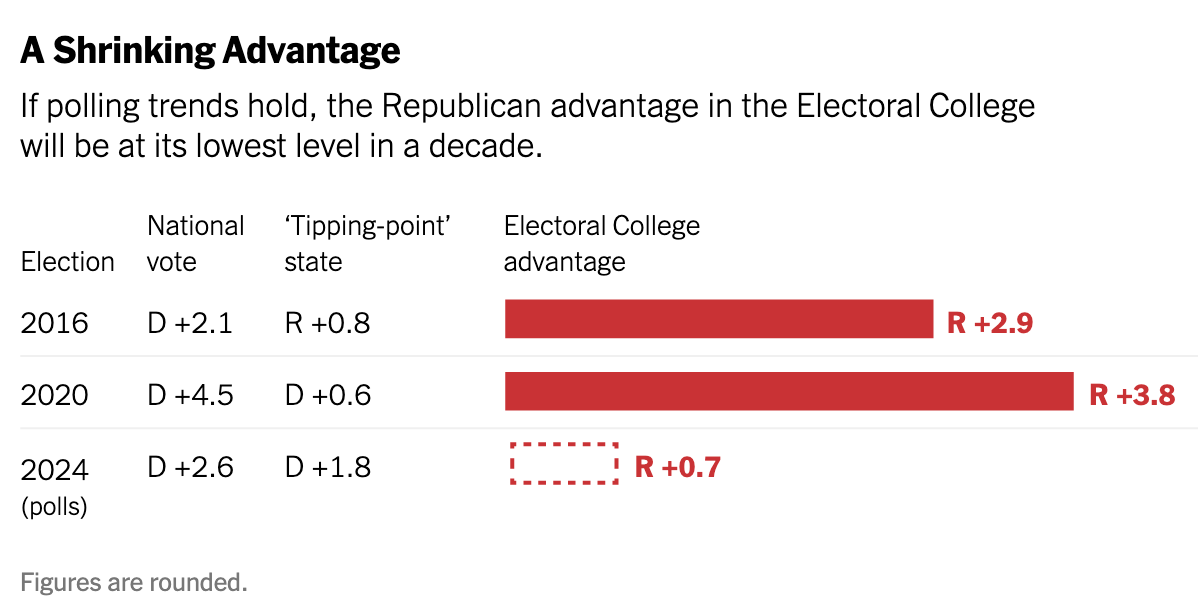sundin13 said:
While I agree that Harris is not leading by much, the conventional wisdom of "She may need to win nationally by 2-3 points to win the election" may be a bit outdated. Per Nate Silver, polling this cycle indicates that the electoral advantage may have significantly shrunk (obviously that is contingent on poll accuracy):
|
On this note, a recent Times poll has Trump up by 13 points in Florida. Which makes me very happy. Because it would help explain the results we are seeing.
Florida has long been a draw for older retirees, especially white ones, due to their low income tax. More recently it has become a mecca for covid deniers, homophobes, transphobes, xenophobes, and confederate sympathizers thanks to good ol' Ron Desantis' policies. It has helped Ron Desantis maintain his seat as governor, but could potential cost the republican party the election.
If the times figure is right, and polls should always be taken with a grain of salt, then we would have to wonder where the votes are coming from. Donald Trump is pretty polarizing, to put it mildly, and it's unlikely his own support jumped among the 2020 voting pool. It is more likely that the 10% jump comes from voters from other states who have relocated.
According to AI, about 2 million people moved to Florida since 2020. Of course, AI is not always accurate, but it seems that about 3-400k people have been moving to Florida each year, so that figure is in the ballpark.
In 2020, Florida had about 10 million voters out of a population of about 20 million. Assuming the people moving are voting at about the same rate, then somewhere between 800k and 1m new residents will be voting. Using very rough math, that would be just about 10%. Of course, it's unlikely all of those people will be voting for Trump, and Florida has a relatively high death rate due to its aging population, but in any event it could be a very big swing. I think 13% is likely overstating it, but 5-6% could be likely.
The question is where those voters are coming from. If they are from NY or California, then that kind of washes out. Florida becomes a safe red state instead of a swing state, which is kind of a bummer. But, suppose some of those people are from swing states... what does that do?
https://247wallst.com/special-report/2024/02/26/americans-are-flocking-to-florida-from-these-states/
According to the never wrong internet, about 10k people from Wisconsin moved to Florida in 2022. Lets assume that was an average year. That means about 40K over 4 years. Lets suppose that 50% of those are adults who will vote. And lets suppose they skew 65-35% republican. That would mean 26k Trump votes are leaving Wisconsin, along with 14K Harris votes. So, a 12K net gain in the democratic vote share. Considering that Biden won the state by about 21K, that's a big deal.
If something similar is happening in Michigan and Pennsylvania, then it would be hard for Trump to win those states. And if Kamala wins those states and all of the safe Democratic states, then she gets to 270 even (luckily the effort to change Nebraska's electoral laws at the 11th hour seems to have failed), and that's the ballgame no matter what happens in Arizona, Nevada, Georgia, or North Carolina.
That's all a vast oversimplification, but point is, there may be something to that shifting demographic theory.

















